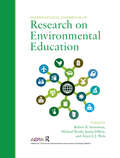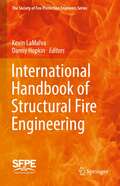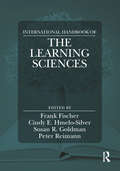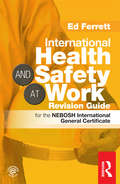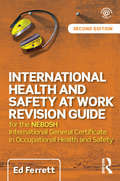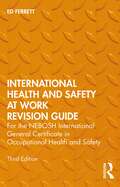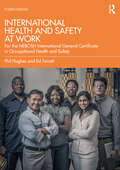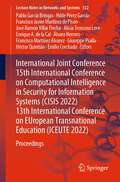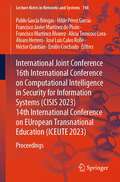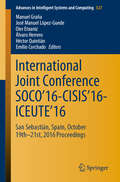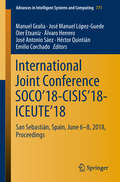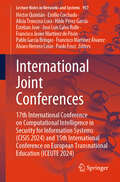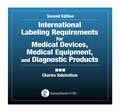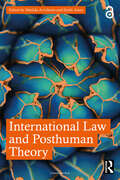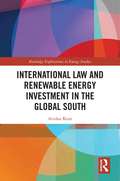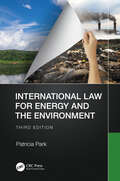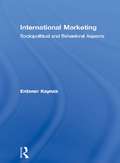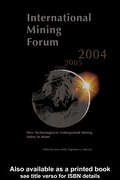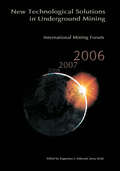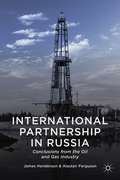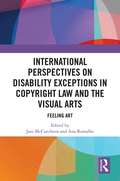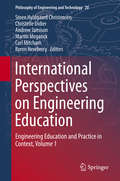- Table View
- List View
International Handbook of Research on Environmental Education
by Justin Dillon Robert B. Stevenson Michael Brody Arjen E.J. WalsThe environment and contested notions of sustainability are increasingly topics of public interest, political debate, and legislation across the world. Environmental education journals now publish research from a wide variety of methodological traditions that show linkages between the environment, health, development, and education. The growth in scholarship makes this an opportune time to review and synthesize the knowledge base of the environmental education (EE) field. The purpose of this 51-chapter handbook is not only to illuminate the most important concepts, findings and theories that have been developed by EE research, but also to critically examine the historical progression of the field, its current debates and controversies, what is still missing from the EE research agenda, and where that agenda might be headed. Published for the American Educational Research Association (AERA).
International Handbook of Structural Fire Engineering (The Society of Fire Protection Engineers Series)
by Kevin LaMalva Danny HopkinThis Handbook is focused on structural resilience in the event of fire. It serves as a single point of reference for practicing structural and fire protection engineers on the topic of structural fire safety. It is also stands as a key point of reference for university students engaged with structural fire engineering.
International Handbook of the Learning Sciences
by Peter Reimann Frank Fischer Cindy E. Hmelo-Silver Susan R. GoldmanThe International Handbook of the Learning Sciences is a comprehensive collection of international perspectives on this interdisciplinary field. In more than 50 chapters, leading experts synthesize past, current, and emerging theoretical and empirical directions for learning sciences research. The three sections of the handbook capture, respectively: foundational contributions from multiple disciplines and the ways in which the learning sciences has fashioned these into its own brand of use-oriented theory, design, and evidence; learning sciences approaches to designing, researching, and evaluating learning broadly construed; and the methodological diversity of learning sciences research, assessment, and analytic approaches. This pioneering collection is the definitive volume of international learning sciences scholarship and an essential text for scholars in this area.
International Health & Safety at Work Revision Guide: for the NEBOSH International General Certificate
by Ed FerrettThis companion to the bestselling International Health and Safety at Work will help you prepare for the written assessments on the NEBOSH International General Certificate in Occupational Health and Safety (October 2009 specification). It provides complete coverage of the syllabus in bite-sized chunks and will help you learn and memorise the most important areas, with links provided back to the main International Health and Safety at Work text to help you consolidate your learning. This revision guide is written by an experienced lecturer who has spent many years helping students become accredited by NEBOSH. Ed Ferrett is former Vice Chairman of NEBOSH (1999-2008) and a lecturer on NEBOSH courses with both public and private course providers. He is a Chartered Engineer and Health and Safety Consultant.
International Health and Safety at Work Revision Guide: for the NEBOSH International General Certificate in Occupational Health and Safety
by Ed FerrettThis companion to the bestselling International Health and Safety at Work is an essential revision aid for students preparing for their written assessments on the NEBOSH International General Certificate in Occupational Health and Safety. Fully updated to the April 2015 specification, the revision guide provides complete coverage of the syllabus in bite-sized chunks, helping readers to learn and memorise the most important topics. Throughout the book, the guide links back to the International Health and Safety at Work textbook, helping students to consolidate their learning. · Small and portable making it ideal for use anywhere: at home, in the classroom or on the move · Suggests useful tips on study and examination technique · Includes practice questions and answers based on NEBOSH exam questions · Everything you need for productive revision in one handy reference The International Health and Safety Revision Guide, written by the renowned health and safety author and former NEBOSH Vice Chairman Ed Ferrett, will be an invaluable tool for students as they prepare for their NEBOSH exam and for their subsequent health and safety work.
International Health and Safety at Work Revision Guide: for the NEBOSH International General Certificate in Occupational Health and Safety
by Ed FerrettThis companion to the renowned International Health and Safety at Work textbook by Hughes and Ferrett is an essential revision aid for students preparing for their written assessments on the NEBOSH International General Certificate in Occupational Health and Safety. Fully updated to the 2019 specification, the revision guide provides complete coverage of the syllabus in bite-sized chunks, helping readers to learn and memorise the most important topics. Throughout the book, the guide links back to the International Health and Safety at Work textbook, helping students to consolidate their learning. Small and portable making it ideal for use anywhere – at home, in the classroom or on the move – the revision guide suggests useful tips on study and examination technique. It includes practice questions and answers based on NEBOSH exam questions, providing everything you need for productive revision in one handy reference. Now in its third edition, the International Health and Safety Revision Guide, written by the renowned health and safety author and former NEBOSH Vice Chairman Ed Ferrett, is an invaluable tool for students as they prepare for their NEBOSH exam and for their subsequent health and safety work.
International Health and Safety at Work: for the NEBOSH International General Certificate in Occupational Health and Safety
by Phil Hughes Ed FerrettInternational Health and Safety at Work has been specially written in simple English for the thousands of students who complete the NEBOSH International General Certificate in Health and Safety each year. Fully revised in alignment with the April 2015 syllabus, this third edition provides students with all they need to tackle the course with confidence. Clear, easily accessible information is presented in full colour, with discussion of essential principles such as ILO and OSH conventions as well as legal frameworks from a range of countries. Aligned to the NEBOSH International General Certificate in Occupational Health and Safety Practice questions and answers to test knowledge and increase understanding Complete with a companion website containing extra resources for tutors and students at www.routledge.com/cw/hughes The only textbook endorsed for the NEBOSH International General Certificate in Health and Safety, International Health and Safety at Work remains the most effective tool for those working to fit international health and safety standards to local needs and practice.
International Health and Safety at Work: for the NEBOSH International General Certificate in Occupational Health and Safety
by Ed Ferrett Phil Hughes MBEInternational Health and Safety at Work has been specially written in simple English for the thousands of students who complete the NEBOSH International General Certificate in Health and Safety each year. Fully revised in alignment with the 2019 syllabus, this fourth edition provides students with all they need to tackle the course with confidence. Clear, easily accessible information is presented in full colour, with discussion of essential principles such as ILO and OSH conventions as well as legal frameworks from a range of countries. The book features practice questions and answers to test knowledge and increase understanding. International Health and Safety at Work remains the most effective tool for those working to fit international health and safety standards to local needs and practice.
International Joint Conference 15th International Conference on Computational Intelligence in Security for Information Systems: Proceedings (Lecture Notes in Networks and Systems #532)
by Álvaro Herrero Héctor Quintián Emilio Corchado Francisco Javier Martínez de Pisón Hilde Pérez García Enrique A. de la Cal Francisco Martínez Álvarez Alicia Troncoso Lora Pablo García Bringas José Ramón Villar Flecha Giuseppe PsailaThis book of Lecture Notes in Networks and Systems contains accepted papers presented at the 15th International Conference on Computational Intelligence in Security for Information Systems (CISIS 2022) and the 13th International Conference on EUropean Transnational Education (ICEUTE 2022). These conferences were held in the beautiful city of Salamanca, Spain, in September 2022. The aim of the CISIS 2022 conference is to offer a meeting opportunity for academic and industry-related researchers belonging to the various, vast communities of computational intelligence, information security, and data mining. The need for intelligent, flexible behaviour by large, complex systems, especially in mission-critical domains, is intended to be the catalyst and the aggregation stimulus for the overall event. After a thorough peer review process, the CISIS 2022 International Program Committee selected 20 papers, which are published in this conference proceedings. In this edition, three special sessions were organized: Cybersecurity in Future Connected Societies, Cybersecurity and Trusted Supply Chains of ICT, and Intelligent Solutions for Cybersecurity Systems. The aim of ICEUTE 2022 is to offer a meeting point for people working on transnational education within Europe. It provides a stimulating and fruitful forum for presenting and discussing the latest works and advances on transnational education within European countries. In the case of ICEUTE 2022, the International Program Committee selected 5 papers, which are also published in this conference proceedings. The selection of papers was extremely rigorous to maintain the high quality of the conferences. We want to thank the members of the Program Committees for their hard work during the reviewing process. This is a crucial process for creating a high-standard conference; the CISIS and ICEUTE would not exist without their help.
International Joint Conference 16th International Conference on Computational Intelligence in Security for Information Systems: Proceedings (Lecture Notes in Networks and Systems #748)
by Álvaro Herrero Héctor Quintián Emilio Corchado Francisco Javier Martínez de Pisón Hilde Pérez García Francisco Martínez Álvarez Alicia Troncoso Lora Pablo García Bringas José Luis Calvo RolleThis book of Lecture Notes in Networks and Systems contains accepted papers presented at the 16th International Conference on Computational Intelligence in Security for Information Systems (CISIS 2023) and the 14th International Conference on EUropean Transnational Education (ICEUTE 2023). These conferences were held in the beautiful city of Salamanca, Spain, in September 2023.The aim of the CISIS 2023 conference is to offer a meeting opportunity for academic and industry-related researchers belonging to the various, vast communities of computational intelligence, information security, and data mining. The need for intelligent, flexible behavior by large, complex systems, especially in mission-critical domains, is intended to be the catalyst and the aggregation stimulus for the overall event. The aim of ICEUTE 2023 conference is to offer a meeting point for people working on transnational education within Europe. It provides a stimulating and fruitful forum for presenting and discussing the latest works and advances on transnational education within European countries.
International Joint Conference SOCO’16-CISIS’16-ICEUTE’16: San Sebastián, Spain, October 19th-21st, 2016 Proceedings (Advances in Intelligent Systems and Computing #527)
by Manuel Graña Álvaro Herrero Héctor Quintián Emilio Corchado José Manuel López-Guede Oier EtxanizThis volume of Advances in Intelligent and Soft Computing contains accepted papers presented at SOCO 2016, CISIS 2016 and ICEUTE 2016, all conferences held in the beautiful and historic city of San Sebastián (Spain), in October 2016.Soft computing represents a collection or set of computational techniques in machine learning, computer science and some engineering disciplines, which investigate, simulate, and analyze very complex issues and phenomena.After a through peer-review process, the 11th SOCO 2016 International Program Committee selected 45 papers. In this relevant edition a special emphasis was put on the organization of special sessions. Two special session was organized related to relevant topics as: Optimization, Modeling and Control Systems by Soft Computing and Soft Computing Methods in Manufacturing and Management Systems.The aim of the 9th CISIS 2016 conference is to offer a meeting opportunity for academic and industry-related researchers belonging to the various, vast communities of Computational Intelligence, Information Security, and Data Mining. The need for intelligent, flexible behaviour by large, complex systems, especially in mission-critical domains, is intended to be the catalyst and the aggregation stimulus for the overall event.After a through peer-review process, the CISIS 2016 International Program Committee selected 20 papers. In the case of 7th ICEUTE 2016, the International Program Committee selected 14 papers.
International Joint Conference SOCO’18-CISIS’18-ICEUTE’18: San Sebastián, Spain, June 6-8, 2018 Proceedings (Advances in Intelligent Systems and Computing #771)
by Manuel Graña Álvaro Herrero Héctor Quintián Emilio Corchado José Manuel López-Guede Oier Etxaniz José Antonio SáezThis book includes papers presented at SOCO 2018, CISIS 2018 and ICEUTE 2018, all held in the beautiful and historic city of San Sebastian (Spain), in June 2018. Soft computing represents a collection or set of computational techniques in machine learning, computer science and some engineering disciplines, which investigate, simulate, and analyze highly complex issues and phenomena. After a rigorous peer-review process, the 13th SOCO 2018 International Program Committee selected 41 papers, with a special emphasis on optimization, modeling and control using soft computing techniques and soft computing applications in the field of industrial and environmental enterprises. The aim of the 11th CISIS 2018 conference was to offer a meeting opportunity for academic and industry researchers from the vast areas of computational intelligence, information security, and data mining. The need for intelligent, flexible behaviour by large, complex systems, especially in mission-critical domains, was the catalyst for the overall event.Eight of the papers included in the book were selected by the CISIS 2018 International Program Committee. The International Program Committee of ICEUTE 2018 selected 11 papers for inclusion in these conference proceedings.
International Joint Conferences: 17th International Conference on Computational Intelligence in Security for Information Systems (CISIS 2024) and 15th International Conference on European Transnational Education (ICEUTE 2024) (Lecture Notes in Networks and Systems #957)
by Héctor Quintián Emilio Corchado Francisco Javier Martínez de Pisón Hilde Pérez García Francisco Martínez Álvarez Alicia Troncoso Lora Pablo García Bringas Esteban Jove José Luis Calvo Rolle Paolo Fosci Álvaro Herrero CosíoThis volume of Lecture Notes in Networks and Systems contains accepted papers presented at the 17th International Conference on Computational Intelligence in Security for Information Systems (CISIS 2024) and the 15th International Conference on EUropean Transnational Education (ICEUTE 2024), which were held in the beautiful city of Salamanca, Spain, in October 2024. The aim of the CISIS 2024 conference is to offer a meeting opportunity for academic and industry-related researchers belonging to the various vast communities of Computational Intelligence, Information Security, and Data Mining. The need for intelligent, flexible behavior by large, complex systems, especially in mission-critical domains, is intended to be the catalyst and the aggregation stimulus for the overall event. After peer review, the CISIS 2024 International Program Committee selected 24 papers for publication in these conference proceedings. In this edition, one special session was organized: Artificial Intelligence for Protecting the Internet of Things. The aim of ICEUTE 2024 conference is to offer a stimulating and fruitful meeting point for people working on transnational education within Europe. It provides an exciting forum for presenting and discussing the latest works and advances in transnational education within European countries. In the case of ICEUTE 2024, the International Program Committee selected nine papers, which are also published in these conference proceedings. The selection of papers was extremely rigorous to maintain the high quality of the conferences. We deeply appreciate the hard work and dedication of the members of the Program Committees during the reviewing process. Their contributions are integral to the creation of a high-standard conference; the CISIS and ICEUTE conferences would not exist without their help.
International Labeling Requirements for Medical Devices, Medical Equipment and Diagnostic Products
by Charles SidebottomCompletely revised, this second edition provides the practical, hands-on labeling information needed to secure rapid regulatory approval, gain marketplace acceptance, and assure user comprehension. A complete guide to all aspects of advertising, labeling, and packaging, it explains the relevant laws, regulations, and requirements in major markets w
International Law and Posthuman Theory
by Emily Jones Matilda ArvidssonAssembling a series of voices from across the field, this book demonstrates how posthuman theory can be employed to better understand and tackle some of the challenges faced by contemporary international law.With the vast environmental devastation being caused by climate change, the increasing use of artificial intelligence by international legal actors and the need for international law to face up to its colonial past, international law needs to change. But in regulating and preserving a stable global order in which states act as its main subjects, the traditional sources of international law – international legal statutes, customary international law, historical precedents and general principles of law – create a framework that slows down its capacity to act on contemporary challenges, and to imagine futures yet to come. In response, this collection maintains that posthuman theory can be used to better address the challenges faced by contemporary international law. Covering a wide array of contemporary topics – including environmental law, the law of the sea, colonialism, human rights, conflict and the impact of science and technology – it is the first book to bring new and emerging research on posthuman theory and international law together into one volume.This book’s posthuman engagement with central international legal debates, prefaced by the leading scholar in the field of posthuman theory, provides a perfect resource for students and scholars in international law, as well as critical and socio-legal theorists and others with interests in posthuman thought, technology, colonialism and ecology.Chapters 1, 9 and 11 of this book is freely available as a downloadable Open Access PDF at http://www.taylorfrancis.com under a Creative Commons Attribution-Non Commercial-No Derivatives (CC-BY-NC-ND) 4.0 license.
International Law and Renewable Energy Investment in the Global South (Routledge Explorations in Energy Studies)
by Avidan KentThis book will discuss the legal tools offered by international law that can support foreign direct investment (FDI) in the renewable energy sector in the Global South. Promoting and increasing investment in the renewable energy sector is crucial for limiting global temperature rise to 1.5°C and addressing energy poverty in the Global South. In this volume, Kent explores the various home-country measures (HCMs) offered by international law that support FDI in the renewable energy sector. This book provides a bird’s eye evaluation of HCMs from fields such as trade law, investment law, environmental law, development law and more. It reveals that while international law indeed offers many legal tools to support investors’ needs, the current legal framework is fragmented; most legal instruments were designed in isolation and the potential for mutually-supportive, synergetic policies has been explored only to a limited extent. This fragmented reality is in contradiction to the notion of Policy Coherence for Development, which is increasingly gaining support in leading institutions in Europe and elsewhere. This book will provide recommendations on the manner in which HCMs can be connected in order to maximise their potential and boost investment in renewable energies in the developing world. International Law and Renewable Energy Investment in the Global South will be of great interest to scholars, students, and practitioners of international law, energy studies, development studies and IR more broadly.
International Law for Energy and the Environment
by Patricia ParkThis revised edition of Energy Law and the Environment considers how international and national legislation now requires the energy sector to focus more on sustainability and the circular economy in response to new policies at both international and national levels. It explores how environmental law engages with multinational companies regarding energy sources, ownership of those resources, and state sovereignty. Written for all the players in the energy sector, lawyers and non-lawyers alike, this third edition considers the issues of energy sector regulation related to economics and protection of intellectual property associated with the development of technologies for mitigating environmentally damaging emissions. It has been updated throughout and adds new and fully revised chapters on subjects, including climate change, human rights, renewable energy, and energy law in China. Features: Updated throughout and adds new and fully revised chapters Focuses on the global trends and mandates towards environmental sustainability Examines the latest international legislation involving climate change Includes the coverage of oil and gas industries, as well as nuclear and renewable energy
International Marketing: Sociopolitical and Behavioral Aspects
by Erdener KaynakSocial, economic, political, business, and cultural environmental factors affect the international marketing operation and performance of international firms. This highly insightful volume focuses on four of the most significant forces with which companies must deal on an international level--macro international marketing issues, sociopolitical int
International Mining Forum 2004, New Technologies in Underground Mining, Safety in Mines: Proceedings of the Fifth International Mining Forum 2004, Cracow - Szczyrk - Wieliczka, Poland, 24-29 February 2004
by Jerzy Kicki Eugeniusz J. SobczykThis book comprises technical papers that were presented at the International Mining Forum 2004. This event aims to bring together scientists and engineers in mining, rock mechanics, and computer engineering, with a view to explore and discuss international developments in the field. The book is addressed to researchers and professionals who work i
International Mining Forum 2006, New Technological Solutions in Underground Mining: Proceedings of the 7th International Mining Forum, Cracow - Szczyrk - Wieliczka, Poland, February 2006
by Jerzy Kicki Eugeniusz J. SobczykThe International Mining Forum is a recurring event, hosted by the University of Science and Technology in Cracow, Poland, bringing together an international group of scientists, including those working in rock mechanics and computer engineering as well as mining engineers. The topics are wide-ranging, including papers on remote sensing to assess p
International Oilfield Surface Facilities: Safety Analysis for Electrical Design
by Kun Ma Yewei Mei Xiaolong Meng Zhaoxia Liu Jingjun Huang Zhiwei LiuThis book mainly introduces an essential safety concept and procedure for electrical engineering in oil and gas field. It begins by providing broad guidelines for performing electrical safety and operability review (ELSOR), giving reader a general overview of the field. It subsequently verifies electrical distribution, overhead line and hazardous area classification safety analysis together with comparison of different international codes and standards with China national codes, to interpret different safety concepts from different countries for electrical engineering in oil and gas field. This unique and complete co-design safety analysis will greatly benefit international electrical engineers and operators of oil and gas fields. This book is with vivid flow chart, accurate table expressing the analysis logic method and exact illustrations of code and standard of different country and area. This book stresses the electrical design safety for surface facilities of oil and gas oil field and will benefit to engineer who works with oil and gas field surface facilities engineering.
International Partnership in Russia
by Et Al. James HendersonInternational Partnership in Russia provides a unique insight into the joint ventures formed by international oil companies in Russia during the post-Soviet era. It outlines the highs and lows in their fortunes and analyses the reasons for their successes and failures.
International Perspectives on Disability Exceptions in Copyright Law and the Visual Arts: Feeling Art
by Jani McCutcheon and Ana RamalhoThis book provides an overview of disability exceptions to copyright infringement and the international and human rights legal framework for disability rights and exceptions. The focus is on those exceptions as they apply to visual art, while the book presents a comprehensive study of copyright’s disability exceptions per se and the international and human rights law framework in which they are situated. 3D printing now allows people with a visual impairment to experience 3D reproductions of paintings, drawings and photographs through touch. At the same time, the uncertain application of existing disability exceptions to these reproductions may generate concerns about legal risk, hampering sensory art projects and reducing inclusivity and equity in cultural engagement by people with a visual impairment. The work adopts an interdisciplinary approach, with contributions from diverse stakeholders, including persons with disabilities, cultural institutions and the 3D printing industry. The book sketches the scene relating to sensory art projects. Experts in intellectual property, human rights, disability and art law then critically analyse the current legal landscape relating to disability access to works of visual art at both international and regional levels, as well as across a broad representative sample of national jurisdictions, and identify where legal reform is required. This comparative analysis of the laws aims to better inform stakeholders of the applicable legal landscape, the legal risks and opportunities associated with sensory art and the opportunities for reform and best practice guidelines, with the overarching goal of facilitating international harmonisation of the law and enhanced inclusivity.
International Perspectives on Engineering Education
by Carl Mitcham Andrew Jamison Steen Hyldgaard Christensen Christelle Didier Martin Meganck Byron NewberryThis inclusive cross-cultural study rethinks the nexus between engineering education and context. In so doing the book offers a reflection on contextual boundaries with an overall boundary crossing ambition and juxtaposes important cases of critical participation within engineering education with sophisticated scholarly reflection on both opportunities and discontents. Whether and in what way engineering education is or ought to be contextualized or de-contextualized is an object of heated debate among engineering educators. The uniqueness of this study is that this debate is given comprehensive coverage - presenting both instrumentally inclined as well as radical positions on transforming engineering education. In contextualizing engineering education, this book offers diverse commentary from a range of disciplinary, meta- and interdisciplinary perspectives on how cultural, professional, institutional and educational systems contexts shape histories, structural dynamics, ideologies and challenges as well as new pathways in engineering education. Topics addressed include examining engineering education in countries ranging from India to America, to racial and gender equity in engineering education and incorporating social awareness into the area. Using context as "bridge" this book confronts engineering education head on. Contending engineering ideologies and corresponding views on context are juxtaposed with contending discourses of reform. The uniqueness of the book is that it brings together scholars from the humanities, the social sciences and engineering from Europe - both East and West - with the United States, China, Brazil, India and Australia.
International Perspectives on Publishing Platforms: Image, Object, Text (Digital Research in the Arts and Humanities)
by Meghan ForbesWith large-scale scholarly projects dedicated to digitizing print-based magazines and a concurrent turn towards digital mapping and data visualization, periodicals that were once accessible only in the archive now have the capacity to reach a wider audience, and make visible previously overlooked networks and connections enacted within and across the magazines. International Perspectives on Publishing Platforms: Image, Object, Text offers a unique contribution to the field of periodical studies, while also broadening the scope of purview to consider related content with regards to other relevant printed matter and cultural products, as well as digital archiving strategies. Including interdisciplinary contributions from academics around the world, the volume presents a wide range of approaches to periodicals and printed matter from Africa, Asia, Europe, the Middle East, Latin America, and the Caribbean. Questions of material print culture and the digital realm are considered both via theoretical and more empirical approaches. As a whole, the book considers the pluralism of perspectives that the study of periodicals and printed matter contribute to our historical understanding of various political and social issues, and also devotes attention to the ways in which digital archiving projects can be instrumentalized as a strategy for filling in gaps in the historical record. International Perspectives on Publishing Platforms should be of great interest to researchers, academics and postgraduates engaged in the study of periodicals, publishing, book history, world literature, digital humanities, media, visual and material culture.
